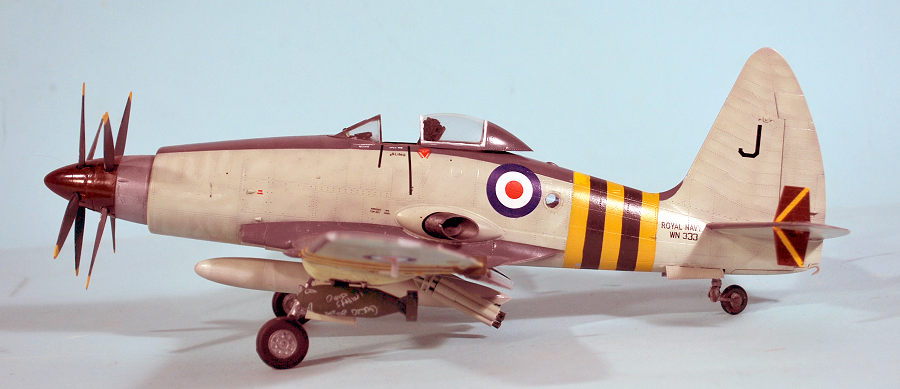
Trumpeter 1/48 Wyvern S.4
| KIT #: | 2820 |
| PRICE: | $54.95 |
| DECALS: | Three options |
| REVIEWER: | Tom Cleaver |
| NOTES: |

| HISTORY |
The Second World War saw the development in naval aviation of a single-seat strike fighter that performed both fighter-bomber and torpedo-strike. In the U.S. Navy, this ed to the Douglas Skyraider, one of the most successf naval aircraft ever built; in the Royal Navy it resulted in the Westland Wyvern,one of the most frustrating naval aircraft ever built, which took ten years to bring to operational readiness, only to be declared obsolete within four years of its arrival on British decks.
The Wyvern was W.E.W. “Teddy” Petter’s last project at Westland before leaving for English Electric where he would design his masterpiece, the Canberra jet bomber. Petter’s objective was a long-range carrier-based day fighter that could carry a torpedo or bombs as appropriate for a secondary role as a strike aircraft. The favored engine was the Rolls-Royce Eagle, a 24-cylinder liquid-cooled “H” type like the Napier Sabre, with 3,500 horsepower. The Naval Staff issued specification N.11/44, written around the Westland proposal. A mockup was created with cockpit atop a significant hump in order to obtain a 15-degree angle of view over the nose for deck landing. It was named “Wyvern” for a mythological dragon, in 1947.
In 1944, Westland began investigating the possibility of changing to the Rolls-Royce RB.39 Clyde turboprop, which Rolls-Royce expected to deliver in December 1945.
The N.11/44 prototype was the biggest British single-seat naval fighter type at the time. To launch from a deck, the airplane required a contraprop, which was developed by Rotol (8-blade) This in turn led to a very large vertical fin to provide directional stability.
The first Turboprop Wyvern, the N.12/45 prototype flew on January 16, 1949, powered by a Clyde. While the Clyde exceeded initial performance estimates, it suffered from a variety of problems, not the least of which was that Rolls-Royce was committed to other engine projects, which kept them from focusing on solving the Clyde’s problems. The Armstrong-Siddeley Python was the only turboprop of the necessary power that could be used for the Wyvern. This change added at least two years to the development cycle as the engineers struggled to create a throttle control that would allow the engine to be rapidly throttled back for a carrier landing, or rapidly throttled up to make a go-around, the solution being an inertia control unit that was, unfortunately, mechanically complex.
The Wyvern finally appeared as the S.Mk.4, and began delivery in May 1953 to equip 813 Squadron. These aircraft did not have the definitive engine control unit and thus were not carrier-compatible until these units were installed in the summer of 1954. The first operational Wyverns went aboard HMS Albion in September 1954, where it was discovered their problems were not over, as there were a series of flameouts during catapult launch as a result of fuel starvation under high-g loading A final design of the ICU/ECU unit solved the flameout problem. 813 and 827 Squadrons embarked aboard HMS Eagle in May 1955 for a second Mediterranean cruise, which gave the Wyverns some 1,500 operating hours and 1,000 landings, after which the aircraft was considered proven.
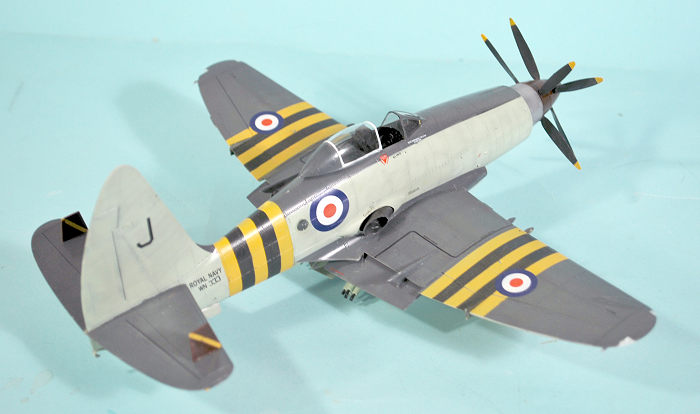 The final
modifications of the S.Mk.4 appeared in early 1956. This was visually
identifiable by the removal of the curved windscreen over the flat armored
glass, a strengthened canopy with a more extensive metal frame, and dive
brakes added under the wing center section. The result was an airplane that
still didn’t provide the performance that was needed, and only continued on
operations due to the fact there was no alternative. It was so short-ranged
it needed a large centerline fuel tank in addition to the wing tanks, and
thus could not carry a torpedo; when it was carrying enough fuel to have
adequate range, it could not get off a carrier deck even with a catapult
while carrying its maximum ordnance load, thus requiring the use of RATOG
units to get airborne.
The final
modifications of the S.Mk.4 appeared in early 1956. This was visually
identifiable by the removal of the curved windscreen over the flat armored
glass, a strengthened canopy with a more extensive metal frame, and dive
brakes added under the wing center section. The result was an airplane that
still didn’t provide the performance that was needed, and only continued on
operations due to the fact there was no alternative. It was so short-ranged
it needed a large centerline fuel tank in addition to the wing tanks, and
thus could not carry a torpedo; when it was carrying enough fuel to have
adequate range, it could not get off a carrier deck even with a catapult
while carrying its maximum ordnance load, thus requiring the use of RATOG
units to get airborne.
813 and 827 Squadrons returned from the Mediterranean and decommissioned in November 1955. They were replaced by 830 and 831 Squadrons which activated in January 1956. 830 Squadron went aboard HMS Eagle that May, destined to be the only unit to fly the Wyvern in combat, when their nine aircraft participated in six days of strikes against Egyptian military targets in the Suez Canal Zone in October-November 1956 as part of Operation Musketeer, the Anglo-French “intervention” in what was called “the Sinai War,” though that was really part of a conspiracy by the two western powers, working with Israel, to regain control of the Suez Canal following its nationalization by Egypt in 1955.
The Wyverns were employed as dive bombers during these operations. On 1 November, 830 Sqn gave the Wyvern its combat debut when, at 0800, six aircraft attacked the former Fleet Air Arm airfield at Dekheila, near Alexandria. Lt. George Barras was on the first strike: “The initial run inshore was a nervous time, with little knowledge of what air opposition there might be. In the event, the attack was virtually unopposed, was repeated twice more that day. Top cover during the attacks was provided by Sea Hawks from 897 and 899 Squadrons.” The squadron flew three strikes through the day, expending 420 rounds of 20mm cannon.
The Wyverns continued in action the following morning when at 0720 five returned to Dekheila. The assessment of the success against the EAF then saw a switch of emphasis, as the attack at midday was against the tanks and vehicles in the Egyptian Army’s main transport and logistics depot at Huckstep Camp, in the western suburbs of Cairo. 830 Sqn’s six Wyverns were the first off from Eagle and the raid was considered a big success, with not a single bomb or rocket falling outside the target area. The squadron flew two more strikes during the day.
Airstrikes against Egyptian targets continued on 3 November and with the threat from EAF MiGs further neutralized, attacks switched to communications and transport targets - specifically, the Damiata (Gamil) Bridge, a solid stone structure to the west of Port Said, the only northern road link from the Nile Delta to the Canal. At 0700 Eagle launched half a dozen Wyverns against the bridge and they achieved a number of near misses that damaged the foundations and the nearby radar site. However, Wyvern WN330/J 379, flown by Lt Dennis McCarthy, was hit in the engine by ground fire and badly damaged, having probably lost a propeller blade: “I got rid of the bombs as quickly as I could and leveled out, heading out to sea. I lost about 200 knots coming out of that dive – it was like hitting a brick wall.” With smoke starting to fill the cockpit and the damaged engine losing power he steered the crippled aircraft seaward, covered by the rest of the formation, until about three miles out when he was forced to eject.
Egyptian shore batteries opened fire as he lay in his dinghy, though covering Sea Hawks attacked them. After an uncomfortable hour and a quarter in the water McCarthy was picked up by a rescue helicopter from Eagle.
Undeterred by this loss, at 1030 six Wyverns returned to the area at low-level with one pilot claiming a direct hit on the bridge. Four more Wyverns mounted a further midafternoon attack, reporting another direct hit. By the end of the day, when the CO of 899 Sqn returned to the ship he reported that one third of the bridge had been destroyed.
Early on the 5th, elements of 16 Airborne Brigade dropped onto their drop zones at El Gamil airfield while the French 2nd Regiment dropped east of the town.
Immediately after the drop, ‘Cab Rank’ - standing patrols of fighter-bombers from Cyprus and the carriers - began to cover the Paras, on call to strafe any troublesome positions.
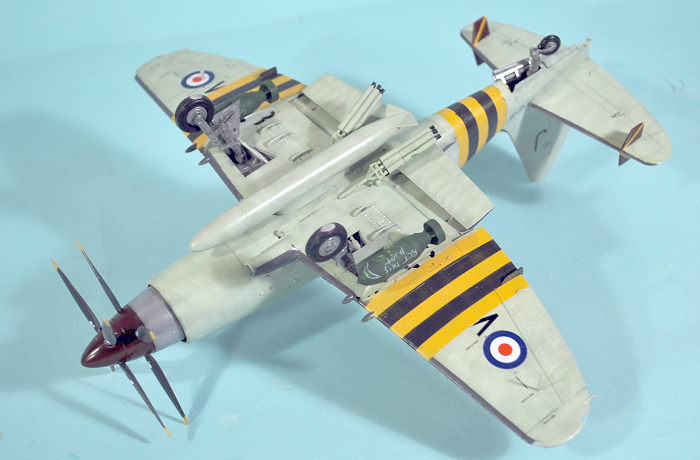 The
Wyverns contributed to this continuous air cover throughout the day over
Gamil and Port Said with its first patrol of five aircraft launching from
Eagle’s deck at 0705. They were called in to make bomb and rocket attacks on
a Coastguard Barracks on the beach road that was proving particularly
troublesome. The first strike damaged it and anti-aircraft gun emplacements
were also knocked out, but the barracks remained standing; all aircraft
returned safely. Three hours later five more Wyverns made further attacks to
hit gun and mortar positions that had been set up in a cemetery.
The
Wyverns contributed to this continuous air cover throughout the day over
Gamil and Port Said with its first patrol of five aircraft launching from
Eagle’s deck at 0705. They were called in to make bomb and rocket attacks on
a Coastguard Barracks on the beach road that was proving particularly
troublesome. The first strike damaged it and anti-aircraft gun emplacements
were also knocked out, but the barracks remained standing; all aircraft
returned safely. Three hours later five more Wyverns made further attacks to
hit gun and mortar positions that had been set up in a cemetery.
The Coastguard barracks was a solid concrete structure, filled with troops and turned into a formidable strongpoint that was still holding up the advance off the drop zone.
The Wyverns were called in again, to demolish it with bombs, at 14:40. Lt.Cmdr. Bill ‘Smokey’ Cowling led the strike on the troublesome barracks. As rockets had proved ineffective Cowling went in low, flying through a veritable hail of small-arms fire and, as he said afterwards: ‘…lobbed a 500-pounder through the window.’ The official report used somewhat more prosaic language to describe the successful attack: ‘Bombs on western two blocks. West block probably destroyed next block badly damaged by bomb and R/P. 20mm on third block. Ground explosion from west building.’
Early on the 5th, elements of 16 Airborne Brigade dropped onto their drop zones at El Gamil airfield whilst the French 2nd Regiment Colonial Parachutist dropped east of the town.
Immediately after the drop, ‘Cab Rank’ - standing patrols of fighter-bombers from Cyprus and the carriers - began to cover the Paras, on call to strafe any troublesome positions.
The Wyverns of 830 Squadron contributed to this continuous air cover throughout the day over Gamil and Port Said with its first patrol of five aircraft launching from Eagle’s deck at 07:05. They were called in to make bomb and rocket attacks on a Coastguard Barracks on the beach road that was proving particularly troublesome. The first strike damaged it and anti-aircraft gun emplacements were also knocked out, but the barracks remained standing; all aircraft returned safely. Three hours later five more Wyverns made further attacks to hit gun and mortar positions that had been set up in a cemetery.
The Coastguard barracks was a solid concrete structure, filled with troops and turned into a formidable strongpoint that was still holding up the advance off the drop zone.
The Wyverns were called in again, to demolish it with bombs, at 1440. Lt-Cmdr. Bill ‘Smokey’ Cowling, flying the CO’s aircraft WN328/J 371, led the strike on the troublesome barracks. As rockets had proved ineffective Cowling went in low, flying through a veritable hail of small-arms fire and, as he said afterwards: ‘…lobbed a 500-pounder through the window.’ The official report used somewhat more prosaic language to describe the successful attack: ‘Bombs on western two blocks. West block probably destroyed next block badly damaged by bomb and R/P. 20mm on third block. Ground explosion from west building.’
The enemy fire was intense, however, as Cowling later recounted: “I was hit by small calibre stuff but was not aware until pulling away. Funny noises – like impeller blades disappearing out of the jet pipe! The engine went into the ‘Red’ and I decided to get as much height as possible and get away from the land. In the event I got up to 1,200ft and had to throttle back as all the indications were that the engine was about to break up. I started screaming ‘Mayday.’ The carrier acknowledged. So did Jim Summerlee who was the rescue helicopter pilot. I pulled down the face-blind which activates the explosive under the seat. I ejected about five miles off the coast of Port Said. Everything worked perfectly.”
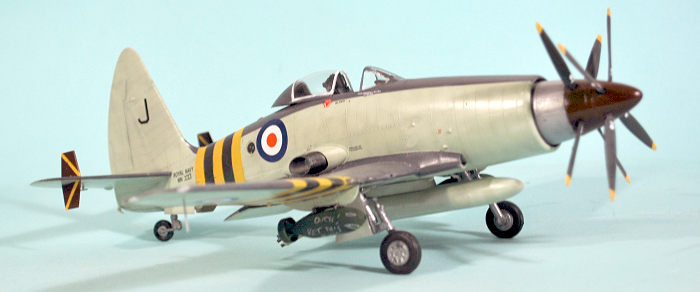 With
remarkable coolness, Bill Cowling had ordered his wingman, Sub-Lt. ‘Scottie’
Scott, to photograph the ejection and record his ‘moment of truth!’
Summerlee and Cowling were colleagues from a previous squadron and
celebrated his safe return later that evening. During the day the Squadron
had dropped 17 bombs, fired 176 rockets and expended more than 2,000 rounds
of 20mm ammunition.
With
remarkable coolness, Bill Cowling had ordered his wingman, Sub-Lt. ‘Scottie’
Scott, to photograph the ejection and record his ‘moment of truth!’
Summerlee and Cowling were colleagues from a previous squadron and
celebrated his safe return later that evening. During the day the Squadron
had dropped 17 bombs, fired 176 rockets and expended more than 2,000 rounds
of 20mm ammunition.
The following morning, the amphibious landing led by Royal Marine Commandos went in at Port Said, once again with on call fighter-bomber cover. 830 Sqn’s first contribution came at 09:30 when six Wyverns, launched and having established their patrol under control of the serving amphibious HQ ship (the frigate HMS Mein), were called on to attack Egyptian troops with cannon and rockets. Fire was also called against two gun positions but having identified the target the leader temporarily believed them to be friendly, only after several confirmatory calls to ensure they were Egyptian were they attacked.
Lt. George Barras flew on the second of 830’s three waves: “I flew on the second wave, armed this time only with ten R/P and the standard 20mm cannon. Attacks were called by ground controllers, and it was rather like bees around a honey pot with the numbers of aircraft waiting to be called in.” Through the day the Wyverns had once more fired a considerable amount of ordnance. However, late that night under intense international pressure, a ceasefire was declared.
In all, Eagle’s squadrons had flown 621 combat sorties during the brief campaign of which 830 Sqn’s Wyverns had flown 79. The CO later recalled: “It was a very small area to operate and after a few days we were competing for the same targets with the other aircraft from the British and French Carriers, it was like Piccadilly Circus. It was an exciting time.”
813 Squadron recommissioned in October 1956, giving the FAA three strike squadrons. With the decommissioning of 830 and 831 Squadrons in January and February 1957, 813 was the last Wyvern operational unit, embarking on HMS Eagle in July 1957 for a tour that lasted until March 1958. 813 decommissioned at Ford on March 29, 1958, which marked the end of active service for the Wyvern. 33 had been lost to all causes during its operational life. The survivors were all melted down during 1959, and the only Wyvern in existence today is the Wyvern Mk.1 VR137, which was never actually flown.
The Westland Wyvern suffered an extended developmental period due to the fact it was one of the first aircraft to use the then-new turboprop. Almost all of the basic technological development that would make later turboprops efficient and reliable was accomplished in this program, which may be the Wyvern’s greatest contribution to aeronautical development.
| THE KIT |
The Wyvern has been a favorite of mine ever since as a wee young aeronut I picked up “The Aircraft of the World” by William Green and Gordon Swanborough at the local library in 1954. The book was an eye-opener: the first I had found with detailed information and photographs of airplanes, and some of them even had detailed three-view drawings; thus was I introduced to good technical aviation history by two of the best writers ever (one of whom I would work for 25 years later). One of the airplanes deemed deserving of those newfangled three-view drawings was something called the Westland Wyvern. I didn’t know a thing about it other than I just liked its look. I still do - a Wyvern is a mythological dragon, and the airplane has a very dragon-like look to me. I laugh every time I think of the Very Well Known Modeler who took a look at one of the many Wyvern models I’ve made over the years (this one being the ID Models vacuform) at the 1988 IPMS Nats and proclaimed it a “what-if” model that didn’t belong in the 1/48 Naval Aircraft category since something that looked like that could never have been actually produced. So much for Model Gnus.
In 1/48, there have been three previous kits of the Wyvern. Two of these were vacuforms, one by ID Models that has long been superseded b the other - a very advanced vacuform that provides everything a modeler needs to create a beautiful model, produced by Dynavector. In 2004, Classic Airframes produced a limited run Wyvern, which built up as the definitive late-production S.Mk.4, with the added-on dive brakes on the lower wing center section, the wing fences inboard of the ailerons to prevent aileron snatch, the late production windscreen with the flat armor glass, and the late canopy with the metal framing for strength.
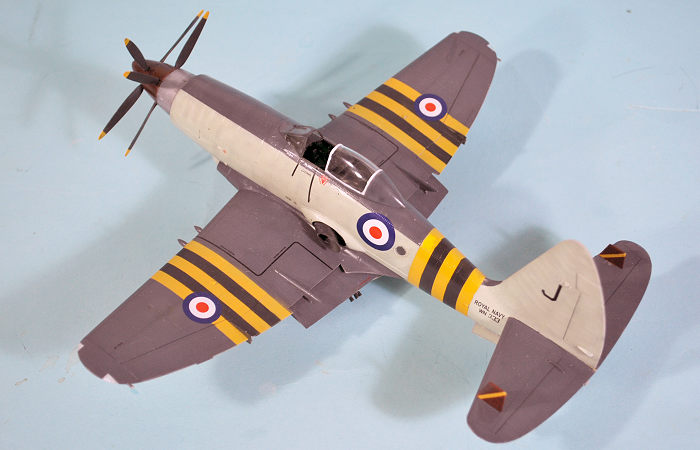 This release
by Trumpeter, which came out in 2006, is still the best of all and is still in
their current catalogue. The kit comes on five light grey sprues of airframe
parts, a sprue of parts for the gearing of the contra-rotating props, and a
sprue of clear plastic for the separate canopy and windshield, camera ports and
navigation lights. There are a total of 220 parts, which include all the
ordnance the airplane was ever supposed to carry, including rockets, 1,000-lb
bombs, a torpedo, the centerline tank and the two wing tanks, as well as the
RATOG units. The kit makes up as a late-version S. Mk.4. In 2008, they released
the kit as an “early version.”
This release
by Trumpeter, which came out in 2006, is still the best of all and is still in
their current catalogue. The kit comes on five light grey sprues of airframe
parts, a sprue of parts for the gearing of the contra-rotating props, and a
sprue of clear plastic for the separate canopy and windshield, camera ports and
navigation lights. There are a total of 220 parts, which include all the
ordnance the airplane was ever supposed to carry, including rockets, 1,000-lb
bombs, a torpedo, the centerline tank and the two wing tanks, as well as the
RATOG units. The kit makes up as a late-version S. Mk.4. In 2008, they released
the kit as an “early version.”
The kit has beautiful restrained surface detail, which is quite accurate, as the accompanying photograph here of a real Wyvern demonstrates.
The kit decals provide markings for three Wyverns: WN325 from 830 Squadron aboard HMS Eagle during Operation Musketeer, WL879 of 813 Squadron during the unit’s final deployment aboard HMS Eagle in 1958, and WN335 of 831 Squadron aboard HMS Ark Royal in 1957. All stencils are provided, as well as nose art for each airplane. The national insignia are the correct size and color. The yellow and black “invasion stripes” are provided as decals for those “stripe-challenged” modelers.
The kit is still available from dealers. I found this second Trumpeter Wyvern in the stacks at the LHS Estate Sale shelves, at a “Make him an offer he cannot refuse” price.
| CONSTRUCTION |
Due to the excellent production design, the Trumpeter Wyvern assembles as easily as a Tamiya kit. With careful assembly, I was able to produce this model without using any putty or Mr. Surfacer on seams.
As with the Tamiya Corsair, the wing when extended is weak, and needs some extra stiffening. I did this the same way I do with the Corsair - I cut some evergreen strip and glued it inside the center wing, giving extra “grab area” for the glue for the outer wing when it is attached to the positioning pins.
 Like the
Skyraider, Dauntless and Helldiver, the Westland Wyvern was not normally seen on
the ground with the wing air brakes extended, so I assembled those closed. If
you attach these to the wings in their component parts, you will get much better
fit, because the assembled air brake is not as thick in section as the wing
where it attaches. Attach the lower part to the lower wing, then attach the
upper part to the upper wing, and then finally attach the forward section, and
all will fit properly.
Like the
Skyraider, Dauntless and Helldiver, the Westland Wyvern was not normally seen on
the ground with the wing air brakes extended, so I assembled those closed. If
you attach these to the wings in their component parts, you will get much better
fit, because the assembled air brake is not as thick in section as the wing
where it attaches. Attach the lower part to the lower wing, then attach the
upper part to the upper wing, and then finally attach the forward section, and
all will fit properly.
The Wyvern was hardly ever seen with the Fowler flaps open on the ground. However, as with most kits that have separate flaps, the flaps fit better in the lowered/open position than they do in the closed position, so I attached them open.
The one thing Trumpeter got wrong is the shape of the propeller blades. They are the more “paddle-shaped” blades used on the prototype. To correct them, they should be more pointed, which is simple to fix with a sanding stick, and I think it took me about 5-6 minutes to do both sets of propellers.
The contra-rotating gizmo the kit provides actually works. Not accurately, since the rear prop rotates at about half the speed of the forward blades, but you can vary the pose of the blades. I would not do this frequently, and I suspect if this was ever motorized the plastic gears would grind away and break in a matter of minutes, but for setting the pose of the model they are adequate.
Another inaccuracy is that kit would have you pose the inner gear doors hanging open. The gear doors on the Wyvern cycled down to lower the gear, then the inner doors cycled back up to the fully-closed position. It’s easy to do this by cutting off the hinges, and the doors fit perfectly to the wheel well opening.
The cockpit provides adequate detail, particularly since everything ends up painted black. The seat provided in the kit is OK, but a resin seat will be better since this is the one item in the cockpit that will catch the eye of the viewer. I had an extra Martin-Baker Mk.2 seat from the Classic Airframes Canberra (no need to stick it in the cockpit when you can’t see it when finished) and used that
I stopped assembly when the main airframe was complete, minus the outboard stabilizing fins on the horizontal stabilizer, the flaps, or any drop tanks or other underwing load, all of which would be painted separately and attached after painting and decaling were completed.
| COLORS & MARKINGS |
First was to paint the wheel wells and gear door interiors with Tamiya Flat Aluminum, which I then went over with Tamiya Smoke to “pop out” detail. I painted the engine cannister with Vallejo aluminum - the kit instructions would have you do this in Dark Grey but that is incorrect.
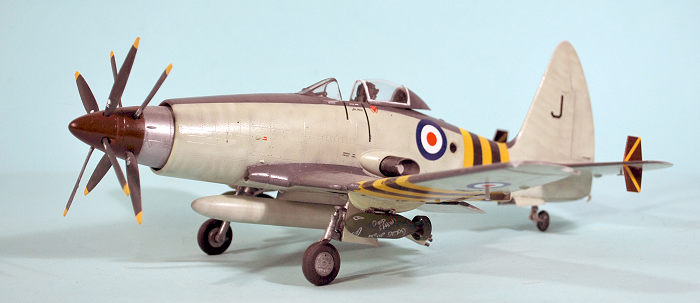 I painted the
yellow for the stripes, then masked them off and painted the black stripes, then
masked that off. I painted the upper color using Tamiya “Dark Grey” and masked
that off, then painted the rest of the model with Tamiya Sky, lightened 20% with
Tamiya Flat White
I painted the
yellow for the stripes, then masked them off and painted the black stripes, then
masked that off. I painted the upper color using Tamiya “Dark Grey” and masked
that off, then painted the rest of the model with Tamiya Sky, lightened 20% with
Tamiya Flat White
The finlets were first painted yellow, then masked, and painted Maroon, as was the prop spinner. These are the right colors for 830 Squadron Wyverns. I have a color photo of Wyverns of this squadron, which is identified as being taken in the fall of 1956, shows both the finlets and the spinner painted Black; interestingly, my camera and Photoshop wanted the Maroon to be black, and that is how I think these areas in the photo became black when the film was developed. When all was dry I unmasked the model and gave it a coat of Gloss Varnish.
While the kit decals are good, on closer examination I noticed a slight off-printing of the national insignia, with a narrow white border along one hemisphere. I substituted insignia left over from an Airfix Spitfire XIV kit which were the right size and opaque. I “mixed and matched” the serial numbers from the kit to do WN333, since I had already done the Operation Musketeer option in the kit when I first reviewed it.
| FINAL CONSTRUCTION |
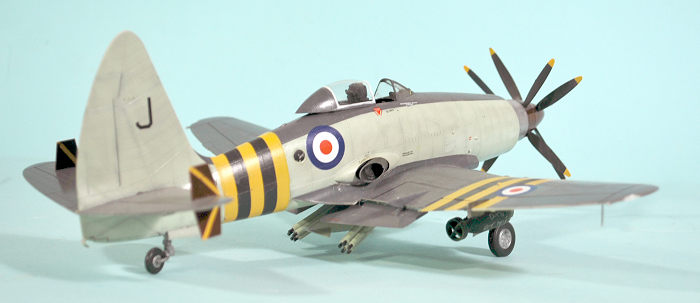 I attached
the landing gear and gear doors, then fit the contraprop without the
gearing. The Wyverns in 839 squadron were used in bombing during Operation
Musketeer, and I mounted two bombs in the outer wing positions, per a photo
taken at the time. I also attempted to copy the messages on the bombs, using
a white color pencil. Writing in 1/48 scale was beyond my capability
however, so they’re just approximations
I attached
the landing gear and gear doors, then fit the contraprop without the
gearing. The Wyverns in 839 squadron were used in bombing during Operation
Musketeer, and I mounted two bombs in the outer wing positions, per a photo
taken at the time. I also attempted to copy the messages on the bombs, using
a white color pencil. Writing in 1/48 scale was beyond my capability
however, so they’re just approximations
Again, the kit instructions would have you paint the bombs Olive Drab, but British bombs are painted Bronze Green. I used Tamiya “Deep Green” which is a close approximation of Bronze Green.
With all that done, I unmasked the windshield and the canopy and posed the canopy open.
| CONCLUSIONS |
This kit assembles as nicely as it looks when you open the box. The kit is in all ways comparable with anything released by Tamiya or Hasegawa, with the additional benefit of being a far more “adventurous” release than either of those companies would ever do nowadays. I never, ever thought I would see a mainstream injection-molded kit of the Wyvern, and certainly not one of this superb quality. This is a kit whose quality has held up over the years.
Highly recommended. Buy in confidence. This kit will make an average modeler look advanced, and an advanced modeler look expert with the resulting model.
9 March 2023
Review kit courtesy of all you book buyers.
Copyright ModelingMadness.com. All rights reserved. No reproduction in part or in whole without express permission from the editor.
If you would like your product reviewed fairly and fairly quickly, please contact the editor or see other details in the Note to Contributors.